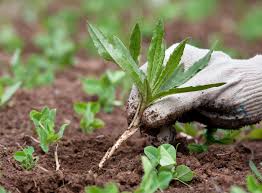Weeding, Maintaining a beautiful garden requires more than just planting and watering—it demands regular weeding. Weeding is the process of removing unwanted plants that compete with your desired plants for nutrients, water, and sunlight. Effective weeding not only improves the health of your garden but also enhances its overall appearance. Here’s a comprehensive guide to mastering the art of weeding.
Why Weeding Matters
Weeds are more than just a nuisance; they can significantly impact the growth and health of your plants. They often harbor pests and diseases, and their rapid growth can overshadow and outcompete your plants for essential resources. By keeping weeds in check, you ensure that your garden thrives and remains visually appealing.
When to Weed
The best time to weed is when the soil is moist, as this makes it easier to remove the entire root system. Early morning or after a rain shower are ideal times. Additionally, it’s wise to keep an eye on your garden regularly, as addressing weeds promptly can prevent them from spreading.
Types of Weeds
Understanding the types of weeds in your garden can help you choose the best approach for removal:
- Annual Weeds: These complete their life cycle in one year. Examples include crabgrass and chickweed. They are often easier to manage since they don’t persist through the winter.
- Perennial Weeds: These weeds live for multiple years and can be more challenging to control. Examples are dandelions and bindweed. They often require more persistent effort to remove their deep root systems.
- Biennial Weeds: These take two years to complete their life cycle. They are less common but include weeds like wild carrots. They can be managed similarly to annual weeds but may require extra vigilance in their second year.
Weeding Techniques
There are several techniques you can use to tackle weeds effectively:
- Hand Pulling: This method is best for small gardens or areas with a manageable number of weeds. Make sure to pull weeds out by the root to prevent regrowth.
- Hoeing: Using a hoe is effective for larger areas or for dealing with weeds in garden beds. Hoeing cuts weeds off at the soil surface, which can be effective for annual weeds but may require multiple passes.
- Mulching: Covering the soil with mulch prevents weed seeds from receiving sunlight and germinating. Organic mulches like straw or wood chips also improve soil quality as they decompose.
- Chemical Weed Killers: Herbicides can be effective but should be used as a last resort due to potential environmental impacts. Always follow instructions carefully and consider using targeted herbicides to minimize damage to desirable plants.
Preventing Weeds
Preventative measures can reduce the amount of weeding you need to do:
- Healthy Soil: Well-aerated and nutrient-rich soil promotes strong plant growth, which helps plants outcompete weeds.
- Dense Planting: Planting your garden densely reduces the space available for weeds to grow.
- Cover Crops: Planting cover crops like clover or rye during the off-season can suppress weeds and improve soil health.
- Regular Maintenance: Consistent garden maintenance, including weeding, helps prevent weeds from becoming a significant problem.
Conclusion
Weeding is an essential part of garden maintenance that contributes to the overall health and beauty of your outdoor space. By understanding the types of weeds, employing effective weeding techniques, and taking preventative measures, you can keep your garden thriving and looking its best. With patience and persistence, your garden will be free of pesky weeds and full of flourishing plants. Happy gardening!
You Might Also Like These:



